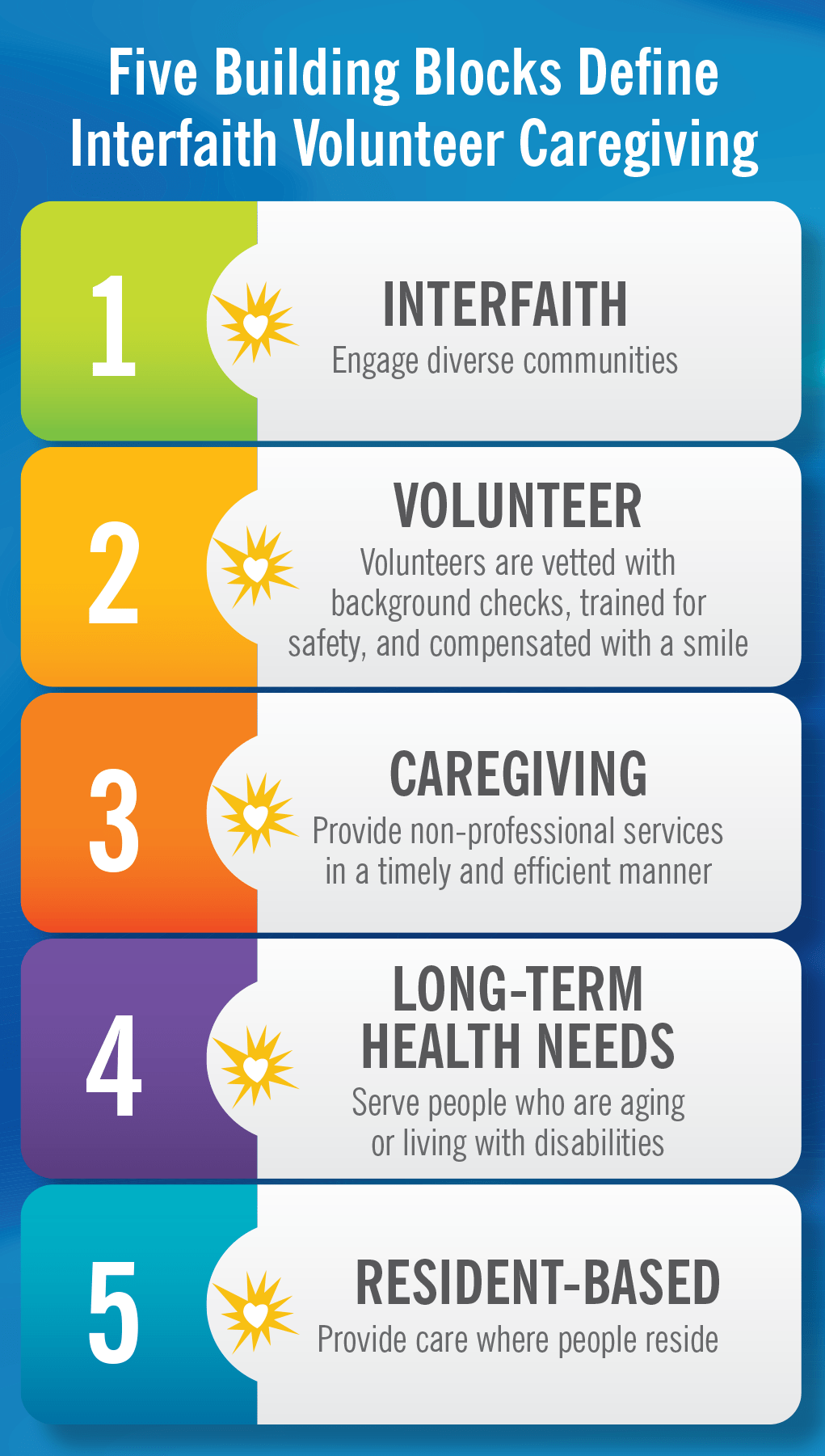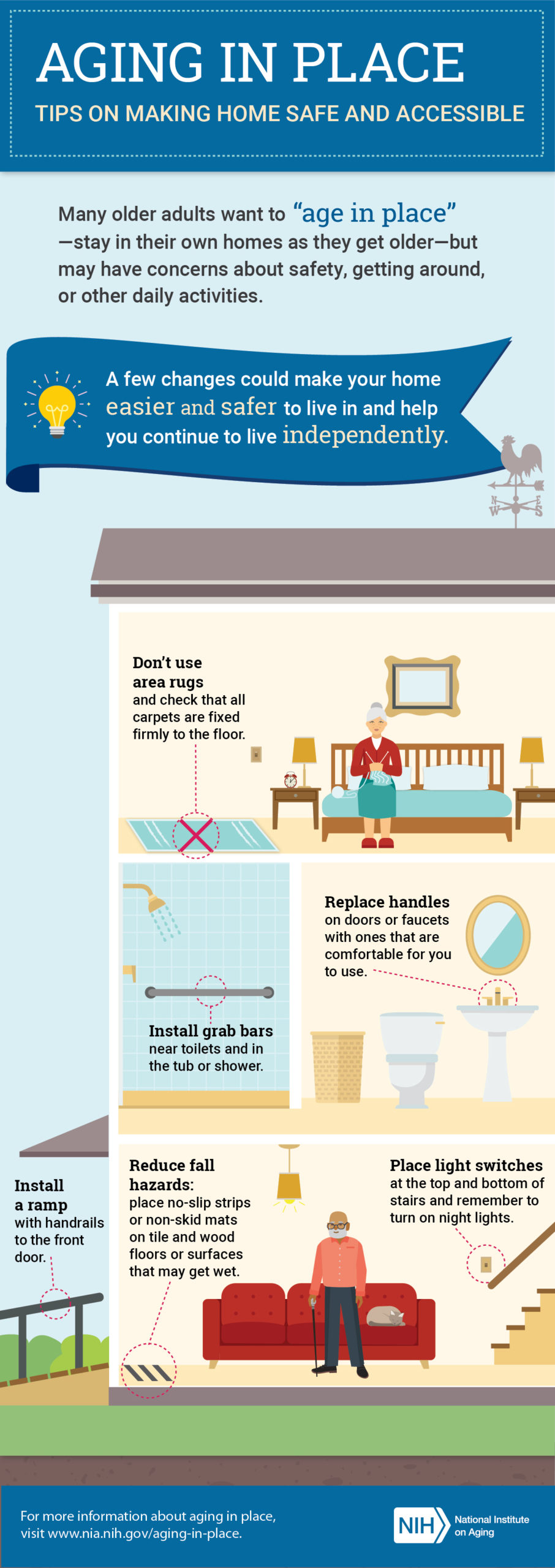
Governance Training for Young Leaders
Overview of Volunteer Caregiving
Objectives
-
- Define Volunteer Caregiving and its benefits
- Understand the history of the National Volunteer Caregiving Network
- Discuss the five building blocks of Interfaith Volunteer Caregiving
- Understand the connection between Volunteer Caregiving and the growing older adult population in the United States.
What is the National Volunteer Caregiving Network (NVCN)
National Volunteer Caregiving Network is an organization that was created in 1984 and designed for other local organizations to provide volunteer caregiving services. The goal is to strengthen and support the programs by sharing best practices in organizational development and management. Local programs can also use or modify NVCN’s resources and tools to meet their own needs. Dating back to 1984, there hasn’t been any reinventions needed to the wheel, such as by-laws, budgets and training materials, which are found in the online toolbox. NVCN also offers several forums where directors and staff can ask questions and share experiences to improve the program’s delivery.

“Hearts & Hands started in one municipality and now touches close to 30. I hope more organizations like ours will continue to be created and flourish though the efforts of our [National Volunteer Caregiving] Network.”
-James Bender, CFRE, Executive Director, Hearts & Hands, Western New York, NY
History of Volunteer Caregiving
Volunteer Caregiving was launched in 1984 to meet the necessities and satisfaction of America’s aging population and individuals with disabilities. NVCN helps with offering multiple services to nearly 1000 different programs all across the nation and throughout the country, including the territories of Guam, Puerto Rico, and the Virgin Islands. The Volunteer Caregiving movement is uniquely designed to meet the social service needs of low-income seniors, elder orphans and those who have disabilities. The model has demonstrated success in being effective as well as economical. The average cost is one-fifth of the cost of comparable non-medical caring services.
What Is Volunteer Caregiving?
A volunteer caregiver is an unpaid member of a person’s social network who helps them with activities of daily living. Since they have no specific professional training, they are often described as informal caregivers. The responsibilities of a volunteer caregiver are to provide assistance with companionship, grocery shopping, household tasks, gardening, running errands, and/or providing transportation to frail, homebound elderly men and women. Volunteer caregivers also provide non-medical companionship and supervision while being a friendly new face for a person with special needs. The goal of a volunteer caregiver is to prevent premature placement into board and care facilities and to make it possible for the elderly to continue to live in the comfort and security of their own home. Lastly, volunteer caregivers promote the health, well-being, dignity, and independence of frail homebound elders through one-on-one companionship.
“Thanks to Volunteer Caregiving, we have been serving hundreds of seniors every year in Ventura County. Our Volunteers provide rides to medical appointments, help prep meals, change light bulbs, and check-in by phone to make sure our folks are doing well. If you need help, call your local program and if you direct volunteers who serve seniors, you’ll want to be part of the National Volunteer Caregiving Network.”
– Tammy I. Glenn, Executive Director, CAREGIVERS: Volunteers Assisting the Elderly, Ventura County, CA
Faith in Action

In 1984, Robert Wood Johnson’s Faith in Action(FIA) funded the Volunteer Caregiving Movement. It provided start-up funding for more than 2,000 communities including the National Volunteer Caregiving Network(NVCN). It emphasizes the need for in-home care. Every volunteer caregiving organization follows this common goal. FIA utilizes the need of both finding volunteers in the community as well as finding those needing care in the community. Johnson’s business plan was to envision the threads of Faith in Action in every program. Today, NVCN has evolved and grown, although their common core remains in the principles of Faith in Action. This successful movement has the opportunity to help change the attitudes toward people aging and people with disabilities. The mission of FIA was to promote interfaith volunteer caregiving to meet the needs of local communities. FIA values “the dignity and worth of every person, the commitment to inclusive care and service, the giving of oneself, the respect for diversity of gifts, the importance of spirituality as a resource for health, the shared dialogue that leads to action, the capacity of volunteer caregiving to invigorate the life of a community, and the unique worth of a volunteer.” Jeanette Wojcak, the Executive Director of a Faith in Action program explained the meaning of FIA and how “The giving of one’s time and energy does make a difference in the lives of others ‘. She explains the importance of human connection and that we cannot exist without interaction with others. Wojcak also describes that this program is meant to allow people to continue to remain independent for as long as possible in the comfort of their homes. FIA highlights, “the realization that all people, regardless of religious beliefs, have a gift to give to others is a powerful force in our world today.” We must all give older adults and those with disabilities love, compassion, and dignity.
Five Building Blocks Define Interfaith Volunteer Caregiving
The National Volunteer Caregiving Network has a set of building blocks that defines interfaith Volunteer Caregiving. The five are Interfaith, Volunteer, Caregiving, Long-Term Health Needs, and Resident-Based. The first, Interfaith, means engaging diverse communities. Volunteering as the second building block is focused on recruiting, training, and coordinating. Next, Caregiving means providing non-professional services in a timely and efficient manner. Long-Term Health Needs are the fourth and it refers to serving people who are aging or living with disabilities. Finally, the last is titled Resident-Based. This means that volunteer caregivers provide care where people reside.
“The reason that I belong is simple. I live next door to the house where Mary once lived, the same Mary to whom I made my promise that I would do what I could to help people, like her, living alone with no one to help them. When I see her house, I am reminded of my promise. Belonging to and supporting NVCN is the best way I know to keep that promise.”
– Paul Jellinek, Mercerville, NJ

Stats About Older Population
Volunteer Caregiving is something everyone can benefit from at one point in our lives. It is no secret, we are born to grow older and sometimes some may need assistance sooner than others. But as mentioned, everyone can benefit from Volunteer Caregiving. By the year 2030, there will be 72.1 million older adults in the US, which is double the number of older adults from 2000. Furthermore, in the year 2020, adults 65 and older represented 12.4% of the population. This percentage is expected to rise to 19% by 2030. Now in the year 2006, adults 85 and older were at 5.3 million and this number is expected to increase to 21 million in 2050. These numbers go to show that as the population increases, there will eventually be more and more older adults who can benefit from Volunteer Caregiving.
Volunteer Caregiving Connection to Aging
Push to Age in Place
Aging in place is something that is mentioned frequently when talking about the stage of older adulthood. It refers to “the ability to live in one’s own home and community safely, independently, and comfortably, regardless of age, income, or ability level.” It has been known to promote life satisfaction, positive self-esteem, and quality of life which helps us remain happy and healthy in old age. Aging in place tends to cost less and it allows the older adults to feel more comfortable. Among those who are 65 and older, around 90% of adults want to stay in their current homes as they age. Although this is what most want for their future, there may always be challenges which is why it’s important to prepare and plan ahead.
The older adult population is growing so there needs to be more careful and thoughtful about how to better help and provide support for older adults. Volunteers are able to help in matters such as household chores, meals, healthcare, and money management. In 2040 the older adults are going to make up 21.7% of the U.S. population. In 2020, the national average cost of an assisted living facility was $51,600 a year. A private room in a nursing home comes out to the national average cost being $105,850 per year. When hearing about these costs it’s no wonder that one of the reasons that older adults want to age in place. When thinking about aging in place the questions that need to be thought of are those surrounding goals, assessment of current and future needs and wants, health care considerations, and financial resources. A home safety assessment is a good way to see and identify any hazards or falls that can be avoided.
How NVCN Helped During COVID
Volunteer Caregiving has played a key role. Older age was a risk factor for the COVID-19 pandemic. Older adults were advised to stay home during the pandemic, therefore NVCN services were as needed as ever. Volunteers were available to drop off groceries and provide services safely. COVID was also the impetus for the development of CareWorks. The proprietary CareWorks system provides a low-cost, online method for volunteer coordination, client services, and donor stewardship. By standardizing the collection of data, NVCN can tell a national story about Volunteer Caregiving that has largely been underreported in the last 40 years. One benefit of consistent messaging will be the opportunity to raise awareness and increase fundraising for this critical mission.
Lead into Other Modules
- Strategic Planning
- Financial Oversight
- Legal and Ethical Integrity
- Human Resources
- Serving as Community Ambassador and Advocate
“NVCN is the best clearinghouse and advocate organization that I have found for volunteer-driven programs.”
-Karen Riordan, Wimberly on Wheels, Texas
Quiz
![]()
